Serving 679 students in grades Prekindergarten-5, Coventry Oak Elementary School ranks in the bottom 50% of all schools in Kentucky for overall test scores (math proficiency is bottom 50%, and reading proficiency is bottom 50%).
The percentage of students achieving proficiency in math is 19% (which is lower than the Kentucky state average of 38%). The percentage of students achieving proficiency in reading/language arts is 25% (which is lower than the Kentucky state average of 45%).
The student:teacher ratio of 12:1 is lower than the Kentucky state level of 15:1.
Minority enrollment is 78% of the student body (majority Hispanic), which is higher than the Kentucky state average of 28% (majority Black and Hispanic).
Quick Stats (2025)
- Grades: Prekindergarten-5
- Enrollment: 679 students
- Student:Teacher Ratio: 12:1
- Minority Enrollment: 78%
- Overall Testing Rank: Bottom 50% in KY
- Math Proficiency: 19% (Btm 50%)
- Reading Proficiency: 25% (Btm 50%)
- Science Proficiency: ≤5% (Btm 50%)
- Source: National Center for Education Statistics (NCES), KY Dept. of Education
Top Rankings
Coventry Oak Elementary School ranks among the top 20% of public schools in Kentucky for:
Category
Attribute
Diversity
Student Attention
School Overview
Coventry Oak Elementary School's student population of 679 students has grown by 15% over five school years.
The teacher population of 56 teachers has grown by 30% over five school years.
Grades Offered
Grades Prekindergarten-5
(offers virtual instruction)
(offers virtual instruction)
Total Students
679 students
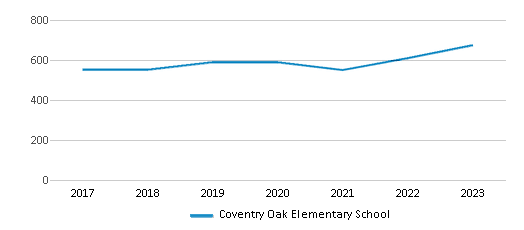
Gender %
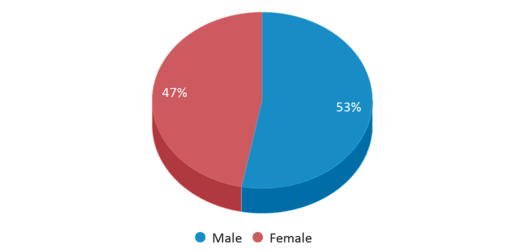
Total Classroom Teachers
56 teachers
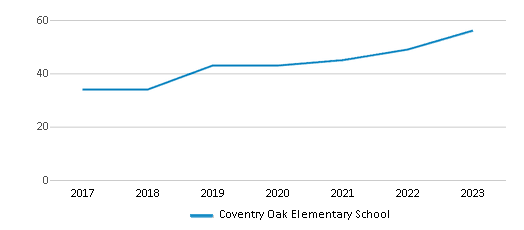
Students by Grade
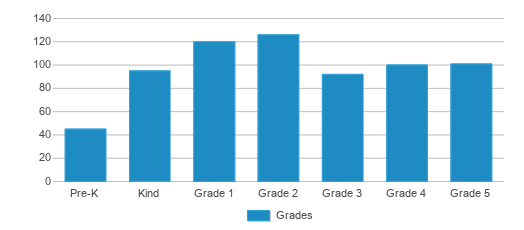
School Rankings
Coventry Oak Elementary School ranks within the bottom 50% of all 1,267 schools in Kentucky (based off of combined math and reading proficiency testing data).
The diversity score of Coventry Oak Elementary School is 0.70, which is more than the diversity score at state average of 0.46. The school's diversity has stayed relatively flat over five school years.
Overall Testing Rank
#1120 out of 1267 schools
(Bottom 50%)
(Bottom 50%)

Math Test Scores (% Proficient)
19%
38%
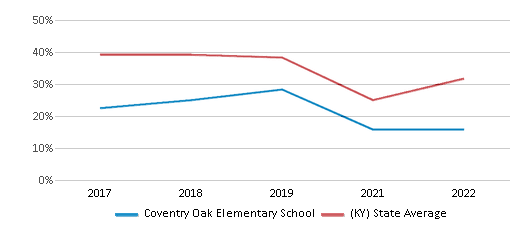
Reading/Language Arts Test Scores (% Proficient)
25%
45%
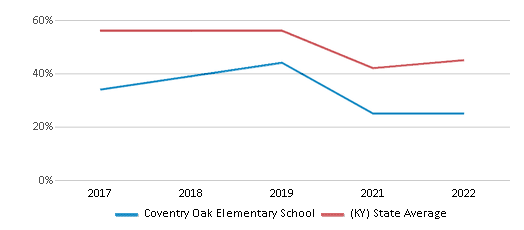
Science Test Scores (% Proficient)
≤5%
22%
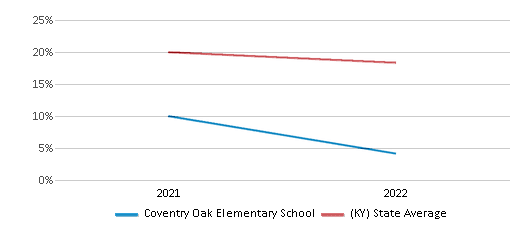
Student : Teacher Ratio
12:1
15:1
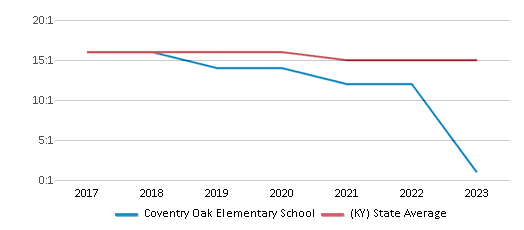
American Indian
n/a
n/a
Asian
2%
2%
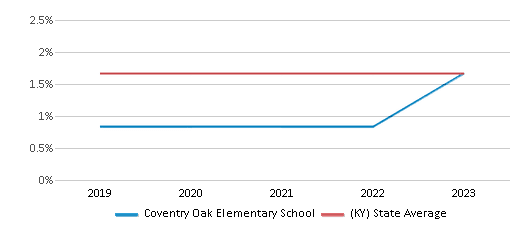
Hispanic
40%
10%
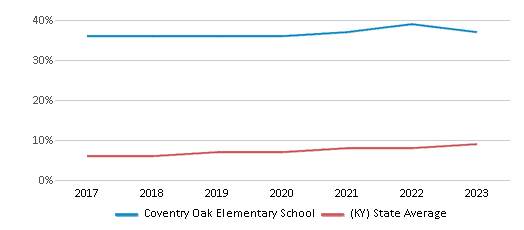
Black
31%
11%
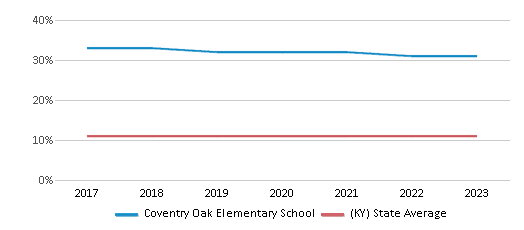
White
22%
72%
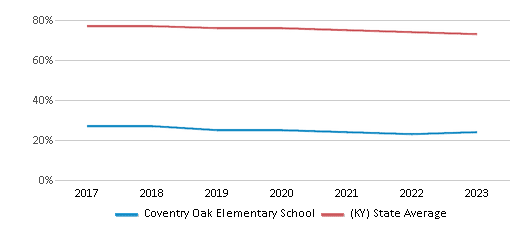
Hawaiian
n/a
n/a
Two or more races
5%
5%
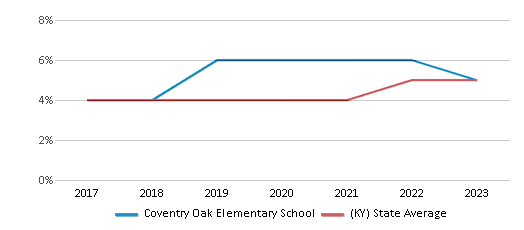
All Ethnic Groups


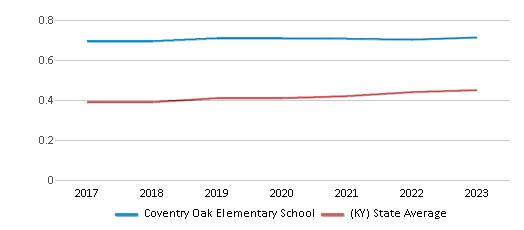
Eligible for Free Lunch
64%
56%
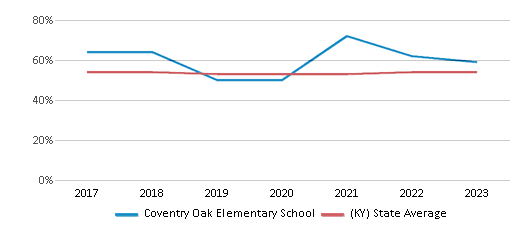
Eligible for Reduced Lunch
4%
3%
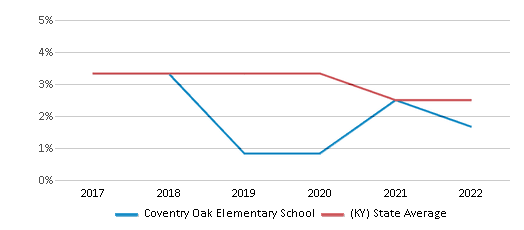
School Statewide Testing
School District Name
Source: National Center for Education Statistics (NCES), KY Dept. of Education
Profile last updated: 02/09/2025
Frequently Asked Questions
What is Coventry Oak Elementary School's ranking?
Coventry Oak Elementary School is ranked #1120 out of 1,267 schools, which ranks it among the bottom 50% of public schools in Kentucky.
What percent of students have achieved state testing proficiency in math and reading?
19% of students have achieved math proficiency (compared to the 38% KY state average), while 25% of students have achieved reading proficiency (compared to the 45% KY state average).
How many students attend Coventry Oak Elementary School?
679 students attend Coventry Oak Elementary School.
What is the racial composition of the student body?
40% of Coventry Oak Elementary School students are Hispanic, 31% of students are Black, 22% of students are White, 5% of students are Two or more races, and 2% of students are Asian.
What is the student:teacher ratio of Coventry Oak Elementary School?
Coventry Oak Elementary School has a student ration of 12:1, which is lower than the Kentucky state average of 15:1.
What grades does Coventry Oak Elementary School offer ?
Coventry Oak Elementary School offers enrollment in grades Prekindergarten-5 (offers virtual instruction).
What school district is Coventry Oak Elementary School part of?
Coventry Oak Elementary School is part of Fayette County School District.
School Reviews
1 3/24/2020
My son attended this school in Kindergarten. It was clear from the very beginning that they did not have time for him. He began kindergarten able to do addition and subtraction and read short books. When they realized this, they put him in front of a computer to teach himself. We discussed this with the teacher and she said that she didn't have the time to make a lesson plan specifically for him and that moving him (or just getting work from 1st grade) was not an option. It took about 2 months before my son, who was excited to go to school began asking what the point of going to school was if he wasn't learning anything new from his teacher and he could just do computer work to learn things. We asked that he be placed in the primary talent pool (like a gifted program from K-3) and they refused. We tried to address the issues with the principal but were never able to get in touch with her. Every time we brought up any concerns to his teacher she would promise she would work with him and would never follow through. She actually admitted that she used him as a helper to assist other children who were having trouble with things he had already mastered. We were able to get my son into a school out of district for the next school year, where within a month he was placed in primary talent pool and had a plan worked out so that he could progress academically while still filling in any gaps for grade level learning. He is now in 2nd grade and is thriving and consistently scoring in the 99th percentile.
Review Coventry Oak Elementary School. Reviews should be a few sentences in length. Please include any comments on:
- Quality of academic programs, teachers, and facilities
- Availability of music, art, sports and other extracurricular activities
Recent Articles

What Is A Charter School?
Explore the world of charter schools in this comprehensive guide. Learn about their history, how they operate, and the pros and cons of this educational innovation. Discover key facts about charter schools, including admission policies, demographics, and funding, as well as what to look for when considering a charter school for your child.

10 Reasons Why High School Sports Benefit Students
Discover the 10 compelling reasons why high school sports are beneficial for students. This comprehensive article explores how athletics enhance academic performance, foster personal growth, and develop crucial life skills. From improved fitness and time management to leadership development and community representation, learn why participating in high school sports can be a game-changer for students' overall success and well-being.

February 05, 2025
Understanding the U.S. Department of Education: Structure, Impact, and EvolutionWe explore how the Department of Education shapes American education, from its cabinet-level leadership to its impact on millions of students, written for general audiences seeking clarity on this vital institution.






